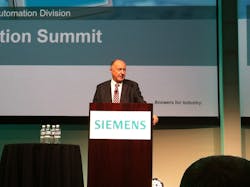Amid a corporate reorganization that involves a realignment of the four sectors around which Siemens focused—energy, infrastructure and cities, heath care, and industry—Siemens Industry Automation Division CEO Anton S. Huber took the stage at the company’s 2014 Automation Summit to explain how the company’s industrial automation focus would continue to evolve.
The key theme of his presentation was how the Internet of Things and Industry 4.0, in particular, are impacting the industries Siemens serves and, in turn, Siemens itself.
Explaining that he sees Industry 4.0 and its drive to digitize and connect all steps in the production process as a part of the Internet of Things (IoT), Huber noted that the biggest impacts of IoT and machine-to-machine (M2M) communication are “acceleration of time to market, increased pressure to reduce costs, higher quality expectations, reduced natural resource consumption, and customizability of products.”
In essence, these technologies (IoT and M2M) aren’t bringing any entirely new concepts to bear on the industrial marketplace, but they will continue to dramatically accelerate the trends industry has been confronting for the past several years.
Noting how “markets and regulatory requirements increase the complexity of products and associated production processes,” Huber said “only a holistic approach including the entire value add chain can yield long-term, competitive automation solutions.” The value chain Huber refers to stretches in all directions from suppliers to customers and includes product design, planning, engineering, execution and even services.
Highlighting how market complexity drives technology complexity, Huber showed examples straight from Siemens’ product line. For example, the 1987 version of the Simatic S5 controller had .03 MB of onboard memory. The 2013 version of the Simatic S7 controller has 16,384 MB of onboard memory. In another example, Huber noted how the current version of Siemens TIA Portal holds 55 million lines of code; the 2010 version of Step 7 software that preceded TIA Portal held just 7 million lines of code.
“This increasing complexity drives the engineering cost of automation.,” Huber said. “Even in China this is occurring, as salaries there are growing 15 percent a year.”
The complexity of digitized manufacturing, connected across the manufacturing value chain, also impacts the amount of product data created and collected. As industry moves from physical prototyping to virtual prototyping, stored product data for a given part or product will be in the hundreds of terabytes, Huber said. But the benefit will be in dramatic time and cost savings to virtually prototype a product versus developing a physical prototype (see photo).
In continuing discussion of Industry 4.0, Huber cited six technology advances that he expects will play significant roles as the initiative plays out. Three of these technologies are machine oriented:
• Direct machining in mass production. Machined metal alloy parts will replace injection-molded plastic housings and frames, Huber said. As an example of how this is already happening, he noted how smart phone and tablet PC manufacturing has already largely changed to direct machining.
• Additive manufacturing will play a major role in custom design. The highest potential use for additive manufacturing will be in low-volume production of complex parts, customized medical implants, and high performance parts, Huber said.
• Safe human-robot cooperation. Advanced safety strategies, combined with innovative and cost-efficient robot designs, now allow safe interaction of human and robots in cooperative work cells.
The other three technologies are software oriented:
• Digitization of all work along value-add processes. “The entire value added production process will be digital from product conception to manufacturing,” said Huber. “This enables simulation and, thereby, a reduction of time-to-market of up to 50 percent”—as noted in his virtual prototyping example (referenced above and in photo).
• Extended enterprise. Supplier and production networks will become deeply integrated through the use of Internet-based PLM software that enables real time collaboration among engineering fields along the value chain.
• Autonomous production. IoT connections and semi-autonomous collaborative robots will work alongside humans, thereby accelerating and stabilizing the high-quality, value add processes.
As for how Siemens will be aligned internally now that its four-sector structure is gone remains to be seen. No official statements have yet been made, but expectations are that the 16 groups that comprised the four sectors will be reconfigured into nine business units. These new units will be designed with the aim of lessening internal bureaucracy and allowing the individual business units to react more directly to changes in the markets they serve, according to a report in The New York Times.

